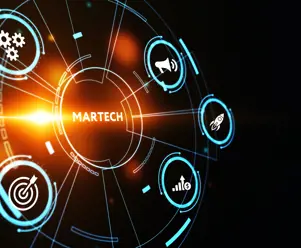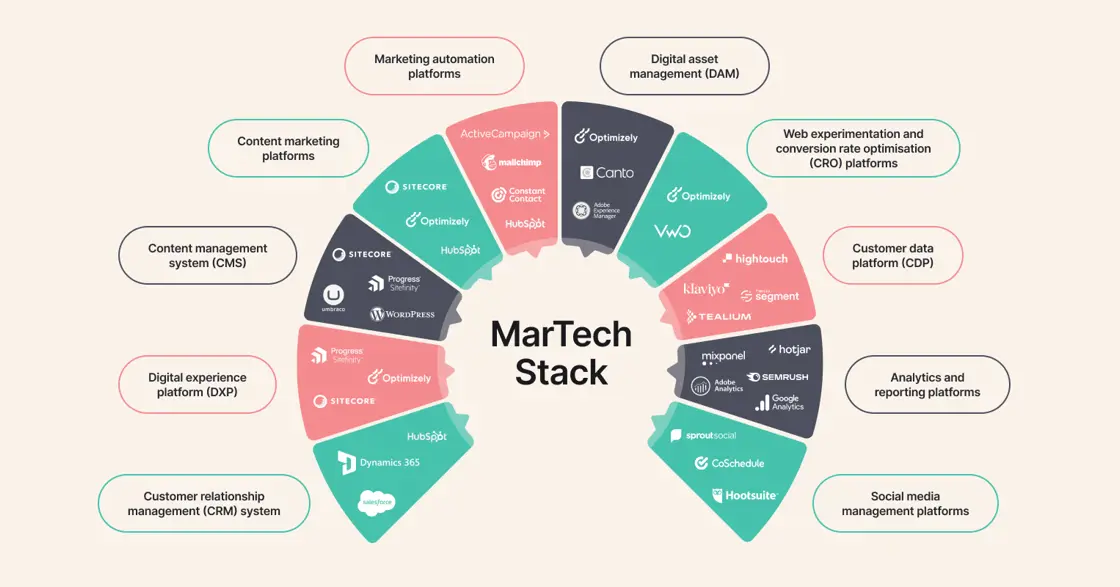Communicating marketing tech stack decisions to non-technical stakeholders

Marketing technology investment
A well-built marketing technology (Martech) stack is a pillar of business growth today. Strategic investments in the right tools and tech go a long way to addressing competing stakeholder demands:
- Customers want personalised experiences
- CMOs want a return on investment with Martech that provides a competitive edge
- Company leaders want to see marketing’s contribution to revenue growth
- Marketers want to spend more time on strategic tasks and less on manual drudgery
- IT wants to prioritise investments that address evolving privacy regulations and don’t add to ‘tech debt’
Highlights
- A well-structured Martech stack is a key to growth in the era of customer-centric, data-driven, efficiency-is-everything marketing.
- Still, securing Martech budgets is challenging, with marketing budgets shrinking and Martech’s share declining.
- ROI requires precise alignment of business goals with tools contributing to revenue, efficiency, and customer-centricity.
- Marketing leaders must address key strategic concerns while engaging non-technical stakeholders if they want to gain buy-in.
- A strategic roadmap, continuous improvement and collaboration are essential for long-term Martech projects.
So, why is securing the budget for new tech investments so hard?
According to Gartner’s latest CMO Survey, marketing budgets shrank 15% in the past 12 months. Martech’s budget share has also been shrinking, from 29.2% in 2018 to just 23.8% today.
One big reason is that the business value of Martech needs to be understood in translation. That’s especially true for enterprise businesses that rely on Martech stacks made up of several technically complex platforms.
Elements of marketing technology stacks
When we talk about a “marketing technology stack,” we collectively refer to the software applications that work together to support customer-facing activities.
The typical Martech stack for a large business will comprise anywhere from 10 to dozens* of tools, including:
-
Customer relationship management (CRM) system, e.g. HubSpot, Salesforce, & Microsoft Dynamics
-
Digital experience platform (DXP), e.g. Optimizely One, Sitefinity, & Sitecore
-
Content management system (CMS), e.g. WordPress, Umbraco, Sitefinity, Sitecore XM Cloud, & Optimizely
-
Content marketing platforms, e.g. Optimizely CM, Sitecore Content Hub, & Hubspot Content Hub
-
Digital asset management (DAM), e.g. Optimizely Digital Asset Management, Adobe Experience Manager, & Canto
-
Marketing automation platforms, e.g. HubSpot, Active Campaign, Constant Contact, Mailchimp
-
Web experimentation and conversion rate optimiser (CRO) platforms, e.g. VWO, & Optimizely Web Experimentation
-
Customer data platform (CDP), e.g. Twilio Segment, Tealium, Hightouch, Klaviyo
-
Analytics and reporting platforms, e.g. GA4, Adobe Analytics, Mixpanel, Hotjar, & Semrush
-
Social media management platforms, e.g. Hootsuite, Sprout Social, CoSchedule
*The scale, spread, and complexity of your marketing technology stack depend on several unique business characteristics, but most big businesses have 20+ tools in play.
Marketing technology is business technology
Although the Martech landscape is exploding – there are over 14,000 products available, 28% more than last year, thanks mainly to an influx of AI tools – there aren’t many enterprise solutions used exclusively for marketing efforts.
For example, a DXP like Optimizely One not only powers digital experiences across the customer lifecycle but is also an operating system for marketing & digital teams, connecting everything from planning and content creation to layout and publishing, to testing, personalisation, and analysis.
HubSpot Customer Platform, built around a CRM and marketing automation platform, now offers content management, operations management, service delivery, and B2B e-commerce software.
A robust headless CMS like Sitefinity enables website, app and intranet functionality beyond marketing borders.
This adds to the complexity of marketing tech stack conversations and makes the outcomes relevant for more people.
How to gain stakeholder buy-in
To get buy-in, key stakeholders must understand how a marketing-led digital transformation project will help them achieve their goals. Here’s how to do that.
1. Identify non-technical stakeholders’ concerns
Enterprise marketing technology requires a pretty hefty investment - not only financial but also time, energy, and equipment. This is made more significant by the reluctance to learn new technology or processes.
So, while customer-centric digital transformation projects have clear benefits, you’ll also need to address concerns.
-
Cost: What are the upfront costs, ongoing maintenance requirements and the total cost of ownership?
-
Compatibility: Will it fit with existing systems and planned investments?
-
Complexity: What is required to implement and integrate this technology?
-
Scalability: Does it enable the next phase of business growth? What about the phase after that?
-
Adoption: What are the user training or change management requirements?
-
Risk: Have you considered privacy regulations, underutilisation, data security and all the other risks?
-
Tech debt: Are we overcapitalising on fancy tools that are more work than they’re worth?
In our experience, these are all valid concerns, but they are also solvable with a solid digital strategy incorporating a digital roadmap and digital experience strategy, which informs the Martech strategy and solution architecture. It’s important not to dismiss them.
Instead, listen for the underlying concern and collaborate with the stakeholders to find a solution.
2. Communicate strategically
Understand your audience
Decision-makers, such as CEOs, CFOs, and CTOs, are focused on performance, efficiency, and growth, not technical intricacies. Other vital stakeholders have different concerns, and framing your discussion to fit your audience’s view will help gain buy-in:
- Senior marketing leaders, including CMOs and Marketing Directors, focus on the customer experience and key marketing metrics like customer acquisition costs and lifetime value.
- Caretakers - IT departments in particular - are interested in the technical details.
- Influencers – regular users – want tools that give back some of their valuable time.
Use clear language
Avoid technical jargon and focus on straightforward explanations. Most end-users and decision-makers are not natively techy. They will focus elsewhere on front-end features, customer outcomes, or ROI.
Clarify what’s at stake
Highlight how specific marketing technology stack choices will drive tangible results. Focus on outcomes like cost savings, improved efficiency, and enhanced customer experiences and link them to big-picture business goals.
3. Engage stakeholders in decision-making
Along with Martech budgets shrinking, utilisation rates have also plummeted to 33%.
Foster an inclusive and collaborative dialogue to prevent the project from falling over due to a lack of trust (on either side or both).
Encourage feedback
Non-technical stakeholders in Martech projects will either be the eventual end-users or those signing the purchase orders. Both deserve to have a voice.
Invite input at every stage. Capture all perspectives and relevant requirements, and demonstrate how they’ve impacted your decision-making.
Leverage expertise
Once the project progresses, involving your marketing agency and technology partners can effectively clarify the benefits of specific features and tools. Most enterprise Martech vendors will happily share their expertise and address questions, especially if they’re involved with the implementation project.
4. Establish a clear roadmap
Think big-picture
Major marketing technology projects take months to implement. Complete Martech stack overhauls take years.
Don’t try to rush it. Marketing technology needs to be configured and deployed correctly to deliver ROI.
This can, understandably, cause tension with stakeholders who need shorter-term solutions. In our experience, a realistic and progressive roadmap is one of the essential tools for stakeholder buy-in.
Seeing the full picture helps people understand that digital transformation projects are about maturing the organisation’s capabilities, not simply adding a new piece of tech.
Get granular (but not too granular)
Individual Martech projects have a lot of moving parts:
-
Dependencies
-
Custom configurations
-
Integrations and APIs
-
Data migration
-
User training
-
Security and stability
Communicating all the technical details in each step will overwhelm non-technical stakeholders. Set the tone with project updates based on critical milestones that resonate with business goals.
5. Keep the conversation going
Your job doesn’t end with implementation or even user acceptance.
Keep stakeholders informed
Establish a regular cadence for project updates, tech developments, feature updates and broader industry changes. Always try to translate these updates so they resonate with non-technical stakeholders.
Document everything
Marketing tech stack strategies are living documents. Record your decisions and make them accessible to all key stakeholders. This is where you can emphasise the connection between business outcomes and technical improvements. Documentation should capture the inputs, challenges, use cases, and technical requirements logically so users can see how their feedback impacted the project.
Encourage continuous improvement
As end users become more confident with the tools and technology becomes more talked about in wider society (thanks, again, to AI), you’ll likely see more technical feedback from the previously non-techy crowd.
That’s a great sign. Specific, experience-based feedback can uncover initiatives that add value. Encouraging it will also discourage people from buying unsanctioned middleware (it happens more often than you might think!)
Partner with equ to make Martech decisions that move the needle
You’re operating in a customer-centric, high-pressure, always-on, hyper-scrutinised world. Marketing technology isn’t a silver bullet but is more valuable than ever.
It’s also more complex.
At equ, we help business leaders navigate these complexities and make strategic decisions that deliver against big-picture goals.
We’re tech-agnostic, growth-focused and customer-first. Whether you’re embarking on an ambitious Martech maturation journey or eager to upgrade your existing Martech stack, we’ll ensure the project is efficient and successful.
Subscribe for insights straight to your inbox
You're all set
Keep an eye on your inbox for updates on equ insights.






